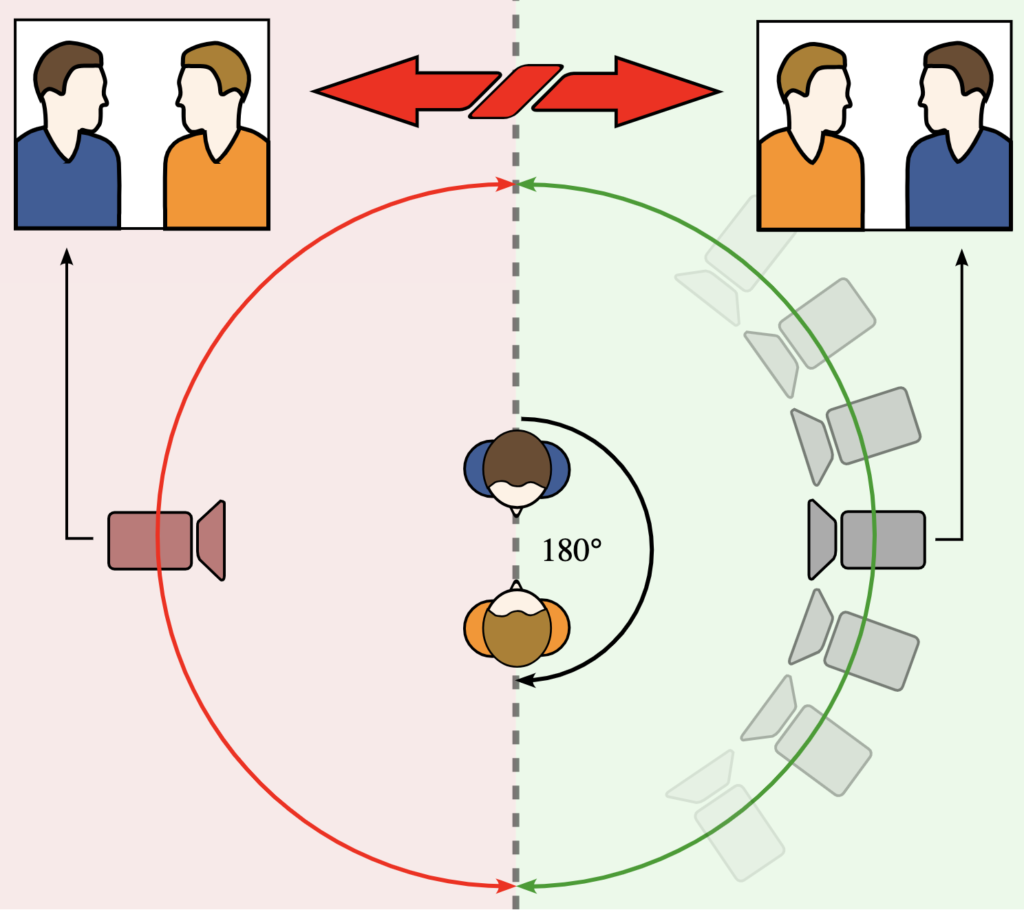Basic Filmmaking Terms and Rules
Terms
The Scene : A part of the story in a single location, taking place in uninterrupted time. A scene is created (usually) by cutting several shots together.
The shot: An angle on a scene.
The take: One version of a specific shot.
The cut: In editing, the change of angle.
The sequence: Α series of scenes which form a distinct narrative unit, usually connected either by unity of location or unity of time.
Continuity and the 180 degree rule:
THE CONTINUITY SYSTEM:
A highly standardized system of editing, now virtually universal in commercial film and television but originally associated with Hollywood cinema, that matches spatial and temporal relations from shot to shot in order to maintain continuous and clear narrative action.
Generally speaking, the continuity system aims to present a scene so that the editing is “invisible” (not consciously noticed by the viewer) and the viewer is never distracted by awkward jumps between shots or by any confusion about the spatial lay-out of the scene. Classical editing achieves a “smooth” and “seamless” style of NARRATION, both because of its conventionality (it is “invisible” in part because we are so used to it) and because it employs a number of powerful techniques designed to maximize a sense of spatial and temporal continuity. A key element of the continuity system is the 180 DEGREE RULE.
From “Film Lexicon” by Peter Donaldson
180 Degree Rule:
This rule states the camera must stay on only one side of the actions and objects in a scene. An invisible line, known as the 180 DEGREE LINE or AXIS OF ACTION, runs through the space of the scene. The camera can shoot from any position within one side of that line, but it may never cross it. This convention ensures that the shot will have consistent spatial relations and screen directions. In other words, characters and objects never “flip flop:” if they are on the right side of the screen, they will remain on the right from shot to shot; those on the left will always be on the left.
For example, an actor walking from the left side of the screen to the right will not suddenly, in the next shot, appear to be walking in the opposite direction — a reversal that would strike the viewer, if only fleetingly, as confusing or jarring. With the 180 DEGREE RULE, the viewer rarely experiences even a momentary sense of spatial disorientation. In theory, the camera may move anywhere on one side of the axis of action.
From “Film Lexicon” by Peter Donaldson

Jump cuts or breaking the 30 degree rule:
Hollywood editing typically adheres to the 30 DEGREE RULE, which holds that the camera must move at least 30 degrees between shots. In other words, it is taboo to show one shot and then cut to another shot that is almost the same as the first. If the angle of framing of two adjacent shots is too similar, it creates the appearance that an object is jumping in a staccato burst from one position to another. Although a number of modernist directors take advantage of this effect, called the JUMP CUT, to draw attention to editing, Hollywood editing avoids it for precisely the same reason.
From “Film Lexicon” by Peter Donaldson
What is a shot list?
A shot list is a document that maps out everything that will happen in a scene of a film, or video, by describing each shot within that film or video. It serves as a kind of checklist, providing the project with a sense of direction and preparedness for the film crew. It is typically made in collaboration with the director, cinematographer, and even first assistant director. Shot lists are especially critical in managing and preparing for film scenes. Making a movie demands knowledge of shot type, camera movement, lighting, actor staging, and much more. Putting this information down in a shot list helps the filmmakers remember what it is they wanted, and how to execute.
Example of a simple shot list
- ES of students taking final with Professor walking back and forth.
- MCU of bad student with headphones on bobbing her head back and forth.
- WS of Professor telling bad student to take headphones off.
- MCU bad student tries to cheat on phone, Professor takes phone away.
- 2 Shot bad student tries to cheat off good student who refuses.
- WS Professor yells at them for talking.

